Personal Cultural Safety Action Plan for Healthcare Professionals
VerifiedAdded on 2022/11/13
|10
|1689
|449
Project
AI Summary
This assignment presents a personal cultural safety action plan designed to improve healthcare practices and patient outcomes. The plan outlines goals to enhance effective communication with patients from diverse backgrounds, ensuring they feel safe and informed. Objectives include fostering open-mindedness, establishing respectful communication skills, and addressing potential barriers such as language differences and trust issues. The plan details strategies for overcoming challenges, such as utilizing translation services and providing cultural competency training. It also emphasizes the importance of organizational culture in creating a welcoming environment. The rationale for the plan highlights the need for measurable activities, resource allocation, and stakeholder accountability. Implementation involves training, resource acquisition, and ongoing evaluation through performance appraisals and patient feedback. The student's plan aims to ensure that patients from all cultures receive respectful and informed care, promoting their well-being and empowerment.
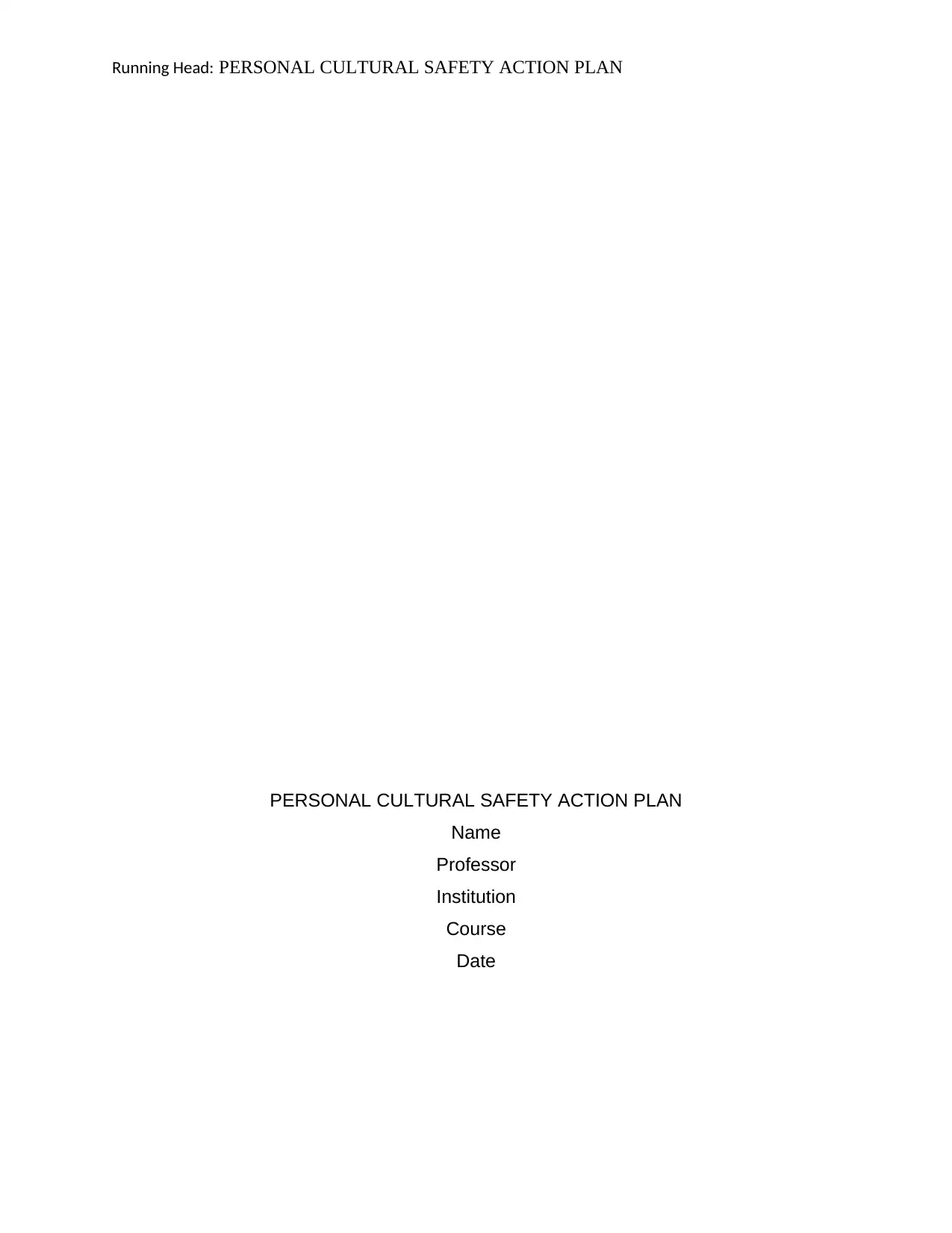
Running Head: PERSONAL CULTURAL SAFETY ACTION PLAN
PERSONAL CULTURAL SAFETY ACTION PLAN
Name
Professor
Institution
Course
Date
PERSONAL CULTURAL SAFETY ACTION PLAN
Name
Professor
Institution
Course
Date
Paraphrase This Document
Need a fresh take? Get an instant paraphrase of this document with our AI Paraphraser
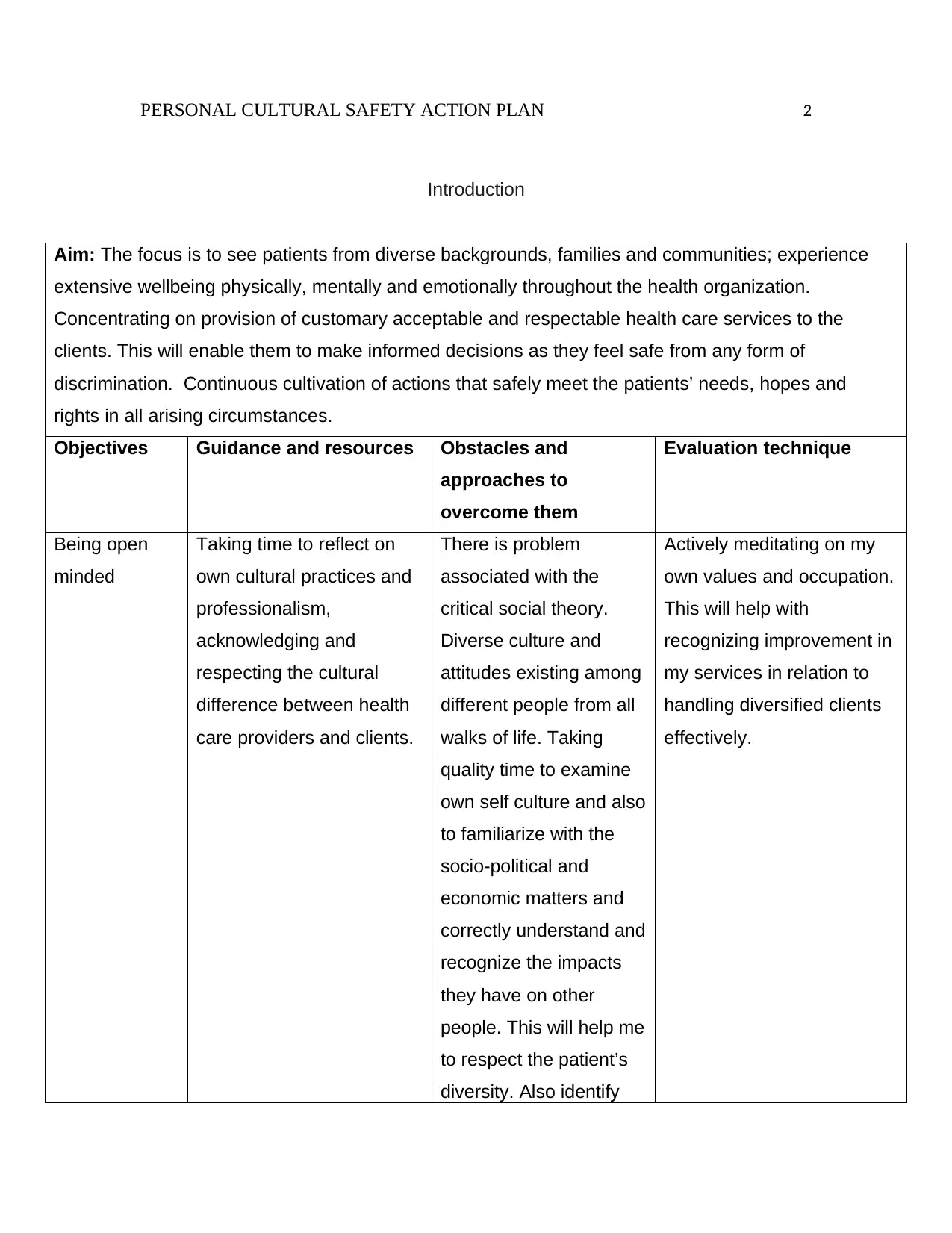
PERSONAL CULTURAL SAFETY ACTION PLAN 2
Introduction
Aim: The focus is to see patients from diverse backgrounds, families and communities; experience
extensive wellbeing physically, mentally and emotionally throughout the health organization.
Concentrating on provision of customary acceptable and respectable health care services to the
clients. This will enable them to make informed decisions as they feel safe from any form of
discrimination. Continuous cultivation of actions that safely meet the patients’ needs, hopes and
rights in all arising circumstances.
Objectives Guidance and resources Obstacles and
approaches to
overcome them
Evaluation technique
Being open
minded
Taking time to reflect on
own cultural practices and
professionalism,
acknowledging and
respecting the cultural
difference between health
care providers and clients.
There is problem
associated with the
critical social theory.
Diverse culture and
attitudes existing among
different people from all
walks of life. Taking
quality time to examine
own self culture and also
to familiarize with the
socio-political and
economic matters and
correctly understand and
recognize the impacts
they have on other
people. This will help me
to respect the patient’s
diversity. Also identify
Actively meditating on my
own values and occupation.
This will help with
recognizing improvement in
my services in relation to
handling diversified clients
effectively.
Introduction
Aim: The focus is to see patients from diverse backgrounds, families and communities; experience
extensive wellbeing physically, mentally and emotionally throughout the health organization.
Concentrating on provision of customary acceptable and respectable health care services to the
clients. This will enable them to make informed decisions as they feel safe from any form of
discrimination. Continuous cultivation of actions that safely meet the patients’ needs, hopes and
rights in all arising circumstances.
Objectives Guidance and resources Obstacles and
approaches to
overcome them
Evaluation technique
Being open
minded
Taking time to reflect on
own cultural practices and
professionalism,
acknowledging and
respecting the cultural
difference between health
care providers and clients.
There is problem
associated with the
critical social theory.
Diverse culture and
attitudes existing among
different people from all
walks of life. Taking
quality time to examine
own self culture and also
to familiarize with the
socio-political and
economic matters and
correctly understand and
recognize the impacts
they have on other
people. This will help me
to respect the patient’s
diversity. Also identify
Actively meditating on my
own values and occupation.
This will help with
recognizing improvement in
my services in relation to
handling diversified clients
effectively.
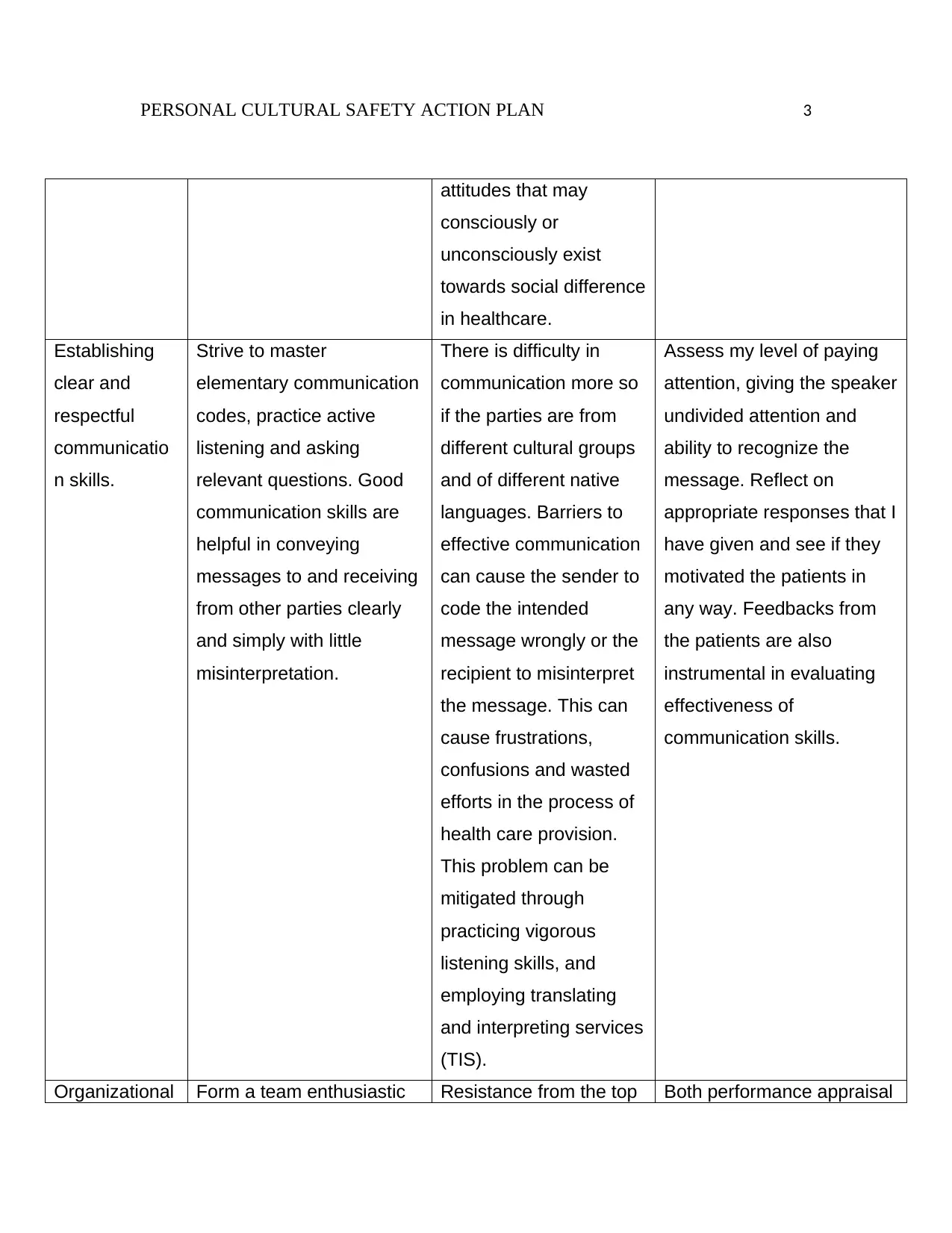
PERSONAL CULTURAL SAFETY ACTION PLAN 3
attitudes that may
consciously or
unconsciously exist
towards social difference
in healthcare.
Establishing
clear and
respectful
communicatio
n skills.
Strive to master
elementary communication
codes, practice active
listening and asking
relevant questions. Good
communication skills are
helpful in conveying
messages to and receiving
from other parties clearly
and simply with little
misinterpretation.
There is difficulty in
communication more so
if the parties are from
different cultural groups
and of different native
languages. Barriers to
effective communication
can cause the sender to
code the intended
message wrongly or the
recipient to misinterpret
the message. This can
cause frustrations,
confusions and wasted
efforts in the process of
health care provision.
This problem can be
mitigated through
practicing vigorous
listening skills, and
employing translating
and interpreting services
(TIS).
Assess my level of paying
attention, giving the speaker
undivided attention and
ability to recognize the
message. Reflect on
appropriate responses that I
have given and see if they
motivated the patients in
any way. Feedbacks from
the patients are also
instrumental in evaluating
effectiveness of
communication skills.
Organizational Form a team enthusiastic Resistance from the top Both performance appraisal
attitudes that may
consciously or
unconsciously exist
towards social difference
in healthcare.
Establishing
clear and
respectful
communicatio
n skills.
Strive to master
elementary communication
codes, practice active
listening and asking
relevant questions. Good
communication skills are
helpful in conveying
messages to and receiving
from other parties clearly
and simply with little
misinterpretation.
There is difficulty in
communication more so
if the parties are from
different cultural groups
and of different native
languages. Barriers to
effective communication
can cause the sender to
code the intended
message wrongly or the
recipient to misinterpret
the message. This can
cause frustrations,
confusions and wasted
efforts in the process of
health care provision.
This problem can be
mitigated through
practicing vigorous
listening skills, and
employing translating
and interpreting services
(TIS).
Assess my level of paying
attention, giving the speaker
undivided attention and
ability to recognize the
message. Reflect on
appropriate responses that I
have given and see if they
motivated the patients in
any way. Feedbacks from
the patients are also
instrumental in evaluating
effectiveness of
communication skills.
Organizational Form a team enthusiastic Resistance from the top Both performance appraisal
⊘ This is a preview!⊘
Do you want full access?
Subscribe today to unlock all pages.

Trusted by 1+ million students worldwide
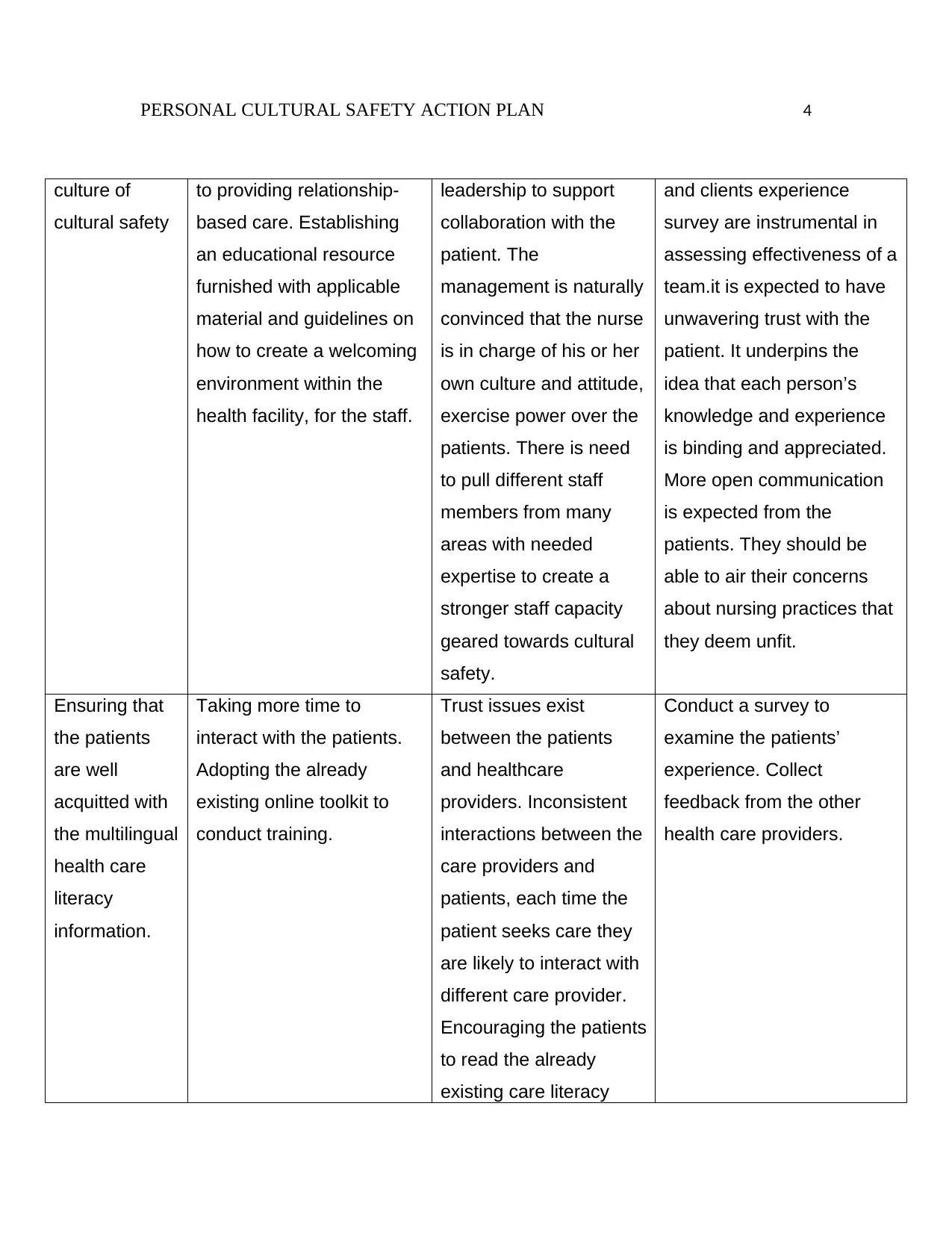
PERSONAL CULTURAL SAFETY ACTION PLAN 4
culture of
cultural safety
to providing relationship-
based care. Establishing
an educational resource
furnished with applicable
material and guidelines on
how to create a welcoming
environment within the
health facility, for the staff.
leadership to support
collaboration with the
patient. The
management is naturally
convinced that the nurse
is in charge of his or her
own culture and attitude,
exercise power over the
patients. There is need
to pull different staff
members from many
areas with needed
expertise to create a
stronger staff capacity
geared towards cultural
safety.
and clients experience
survey are instrumental in
assessing effectiveness of a
team.it is expected to have
unwavering trust with the
patient. It underpins the
idea that each person’s
knowledge and experience
is binding and appreciated.
More open communication
is expected from the
patients. They should be
able to air their concerns
about nursing practices that
they deem unfit.
Ensuring that
the patients
are well
acquitted with
the multilingual
health care
literacy
information.
Taking more time to
interact with the patients.
Adopting the already
existing online toolkit to
conduct training.
Trust issues exist
between the patients
and healthcare
providers. Inconsistent
interactions between the
care providers and
patients, each time the
patient seeks care they
are likely to interact with
different care provider.
Encouraging the patients
to read the already
existing care literacy
Conduct a survey to
examine the patients’
experience. Collect
feedback from the other
health care providers.
culture of
cultural safety
to providing relationship-
based care. Establishing
an educational resource
furnished with applicable
material and guidelines on
how to create a welcoming
environment within the
health facility, for the staff.
leadership to support
collaboration with the
patient. The
management is naturally
convinced that the nurse
is in charge of his or her
own culture and attitude,
exercise power over the
patients. There is need
to pull different staff
members from many
areas with needed
expertise to create a
stronger staff capacity
geared towards cultural
safety.
and clients experience
survey are instrumental in
assessing effectiveness of a
team.it is expected to have
unwavering trust with the
patient. It underpins the
idea that each person’s
knowledge and experience
is binding and appreciated.
More open communication
is expected from the
patients. They should be
able to air their concerns
about nursing practices that
they deem unfit.
Ensuring that
the patients
are well
acquitted with
the multilingual
health care
literacy
information.
Taking more time to
interact with the patients.
Adopting the already
existing online toolkit to
conduct training.
Trust issues exist
between the patients
and healthcare
providers. Inconsistent
interactions between the
care providers and
patients, each time the
patient seeks care they
are likely to interact with
different care provider.
Encouraging the patients
to read the already
existing care literacy
Conduct a survey to
examine the patients’
experience. Collect
feedback from the other
health care providers.
Paraphrase This Document
Need a fresh take? Get an instant paraphrase of this document with our AI Paraphraser

PERSONAL CULTURAL SAFETY ACTION PLAN 5
online whenever they
can access the internet.
Enabling comfortable
and secretive
environment will help to
solve trust issues.
Part2: Justification
online whenever they
can access the internet.
Enabling comfortable
and secretive
environment will help to
solve trust issues.
Part2: Justification
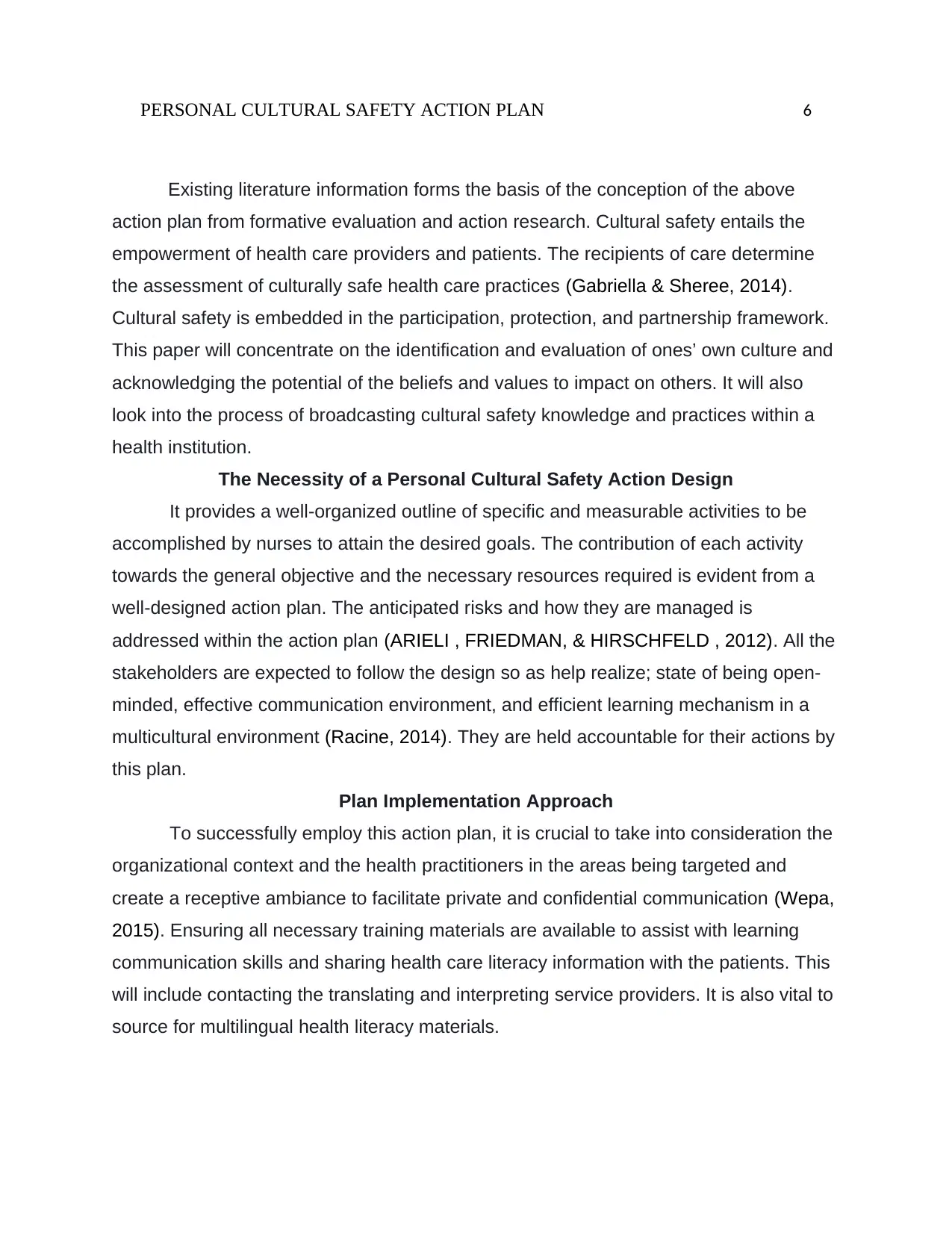
PERSONAL CULTURAL SAFETY ACTION PLAN 6
Existing literature information forms the basis of the conception of the above
action plan from formative evaluation and action research. Cultural safety entails the
empowerment of health care providers and patients. The recipients of care determine
the assessment of culturally safe health care practices (Gabriella & Sheree, 2014).
Cultural safety is embedded in the participation, protection, and partnership framework.
This paper will concentrate on the identification and evaluation of ones’ own culture and
acknowledging the potential of the beliefs and values to impact on others. It will also
look into the process of broadcasting cultural safety knowledge and practices within a
health institution.
The Necessity of a Personal Cultural Safety Action Design
It provides a well-organized outline of specific and measurable activities to be
accomplished by nurses to attain the desired goals. The contribution of each activity
towards the general objective and the necessary resources required is evident from a
well-designed action plan. The anticipated risks and how they are managed is
addressed within the action plan (ARIELI , FRIEDMAN, & HIRSCHFELD , 2012). All the
stakeholders are expected to follow the design so as help realize; state of being open-
minded, effective communication environment, and efficient learning mechanism in a
multicultural environment (Racine, 2014). They are held accountable for their actions by
this plan.
Plan Implementation Approach
To successfully employ this action plan, it is crucial to take into consideration the
organizational context and the health practitioners in the areas being targeted and
create a receptive ambiance to facilitate private and confidential communication (Wepa,
2015). Ensuring all necessary training materials are available to assist with learning
communication skills and sharing health care literacy information with the patients. This
will include contacting the translating and interpreting service providers. It is also vital to
source for multilingual health literacy materials.
Existing literature information forms the basis of the conception of the above
action plan from formative evaluation and action research. Cultural safety entails the
empowerment of health care providers and patients. The recipients of care determine
the assessment of culturally safe health care practices (Gabriella & Sheree, 2014).
Cultural safety is embedded in the participation, protection, and partnership framework.
This paper will concentrate on the identification and evaluation of ones’ own culture and
acknowledging the potential of the beliefs and values to impact on others. It will also
look into the process of broadcasting cultural safety knowledge and practices within a
health institution.
The Necessity of a Personal Cultural Safety Action Design
It provides a well-organized outline of specific and measurable activities to be
accomplished by nurses to attain the desired goals. The contribution of each activity
towards the general objective and the necessary resources required is evident from a
well-designed action plan. The anticipated risks and how they are managed is
addressed within the action plan (ARIELI , FRIEDMAN, & HIRSCHFELD , 2012). All the
stakeholders are expected to follow the design so as help realize; state of being open-
minded, effective communication environment, and efficient learning mechanism in a
multicultural environment (Racine, 2014). They are held accountable for their actions by
this plan.
Plan Implementation Approach
To successfully employ this action plan, it is crucial to take into consideration the
organizational context and the health practitioners in the areas being targeted and
create a receptive ambiance to facilitate private and confidential communication (Wepa,
2015). Ensuring all necessary training materials are available to assist with learning
communication skills and sharing health care literacy information with the patients. This
will include contacting the translating and interpreting service providers. It is also vital to
source for multilingual health literacy materials.
⊘ This is a preview!⊘
Do you want full access?
Subscribe today to unlock all pages.

Trusted by 1+ million students worldwide
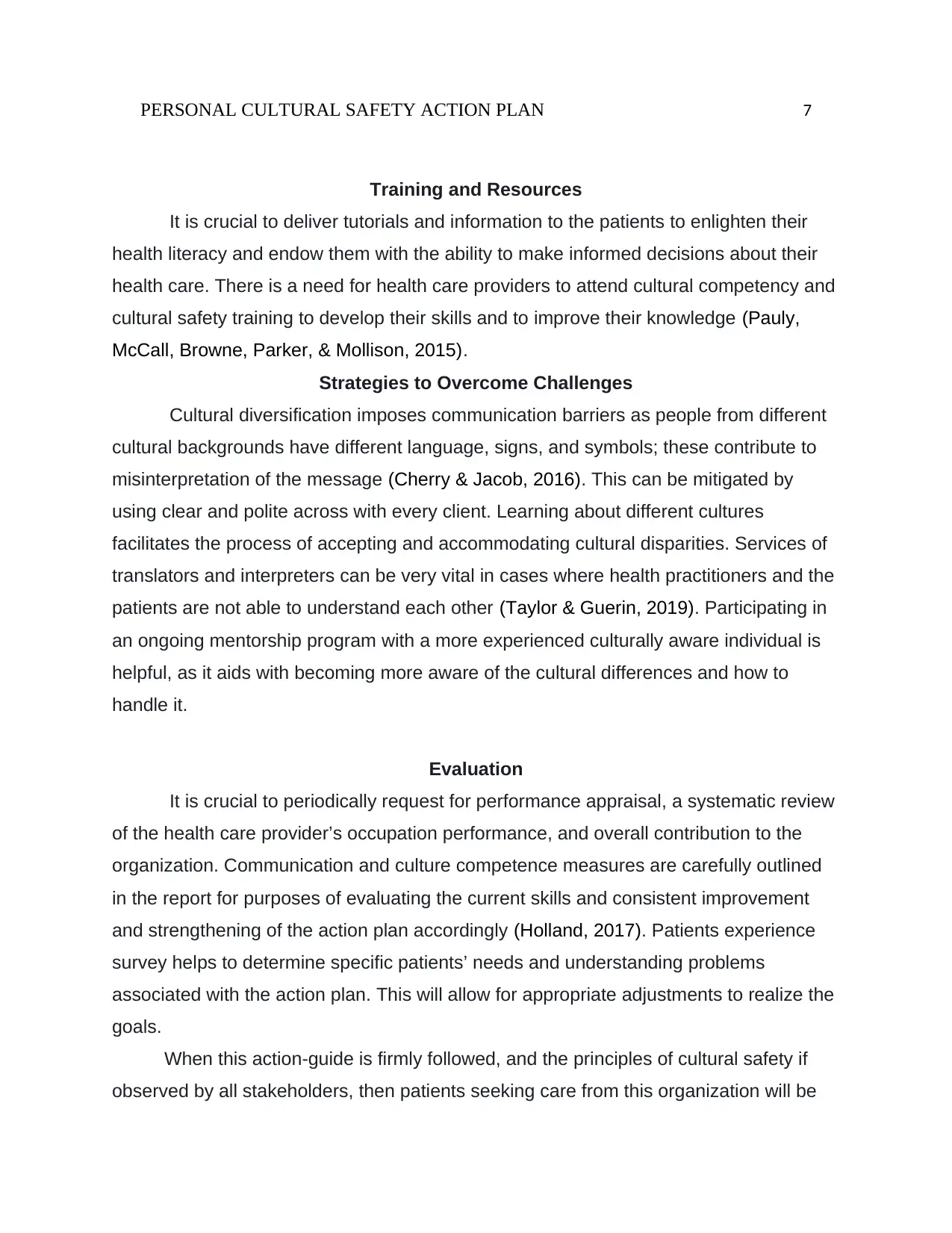
PERSONAL CULTURAL SAFETY ACTION PLAN 7
Training and Resources
It is crucial to deliver tutorials and information to the patients to enlighten their
health literacy and endow them with the ability to make informed decisions about their
health care. There is a need for health care providers to attend cultural competency and
cultural safety training to develop their skills and to improve their knowledge (Pauly,
McCall, Browne, Parker, & Mollison, 2015).
Strategies to Overcome Challenges
Cultural diversification imposes communication barriers as people from different
cultural backgrounds have different language, signs, and symbols; these contribute to
misinterpretation of the message (Cherry & Jacob, 2016). This can be mitigated by
using clear and polite across with every client. Learning about different cultures
facilitates the process of accepting and accommodating cultural disparities. Services of
translators and interpreters can be very vital in cases where health practitioners and the
patients are not able to understand each other (Taylor & Guerin, 2019). Participating in
an ongoing mentorship program with a more experienced culturally aware individual is
helpful, as it aids with becoming more aware of the cultural differences and how to
handle it.
Evaluation
It is crucial to periodically request for performance appraisal, a systematic review
of the health care provider’s occupation performance, and overall contribution to the
organization. Communication and culture competence measures are carefully outlined
in the report for purposes of evaluating the current skills and consistent improvement
and strengthening of the action plan accordingly (Holland, 2017). Patients experience
survey helps to determine specific patients’ needs and understanding problems
associated with the action plan. This will allow for appropriate adjustments to realize the
goals.
When this action-guide is firmly followed, and the principles of cultural safety if
observed by all stakeholders, then patients seeking care from this organization will be
Training and Resources
It is crucial to deliver tutorials and information to the patients to enlighten their
health literacy and endow them with the ability to make informed decisions about their
health care. There is a need for health care providers to attend cultural competency and
cultural safety training to develop their skills and to improve their knowledge (Pauly,
McCall, Browne, Parker, & Mollison, 2015).
Strategies to Overcome Challenges
Cultural diversification imposes communication barriers as people from different
cultural backgrounds have different language, signs, and symbols; these contribute to
misinterpretation of the message (Cherry & Jacob, 2016). This can be mitigated by
using clear and polite across with every client. Learning about different cultures
facilitates the process of accepting and accommodating cultural disparities. Services of
translators and interpreters can be very vital in cases where health practitioners and the
patients are not able to understand each other (Taylor & Guerin, 2019). Participating in
an ongoing mentorship program with a more experienced culturally aware individual is
helpful, as it aids with becoming more aware of the cultural differences and how to
handle it.
Evaluation
It is crucial to periodically request for performance appraisal, a systematic review
of the health care provider’s occupation performance, and overall contribution to the
organization. Communication and culture competence measures are carefully outlined
in the report for purposes of evaluating the current skills and consistent improvement
and strengthening of the action plan accordingly (Holland, 2017). Patients experience
survey helps to determine specific patients’ needs and understanding problems
associated with the action plan. This will allow for appropriate adjustments to realize the
goals.
When this action-guide is firmly followed, and the principles of cultural safety if
observed by all stakeholders, then patients seeking care from this organization will be
Paraphrase This Document
Need a fresh take? Get an instant paraphrase of this document with our AI Paraphraser
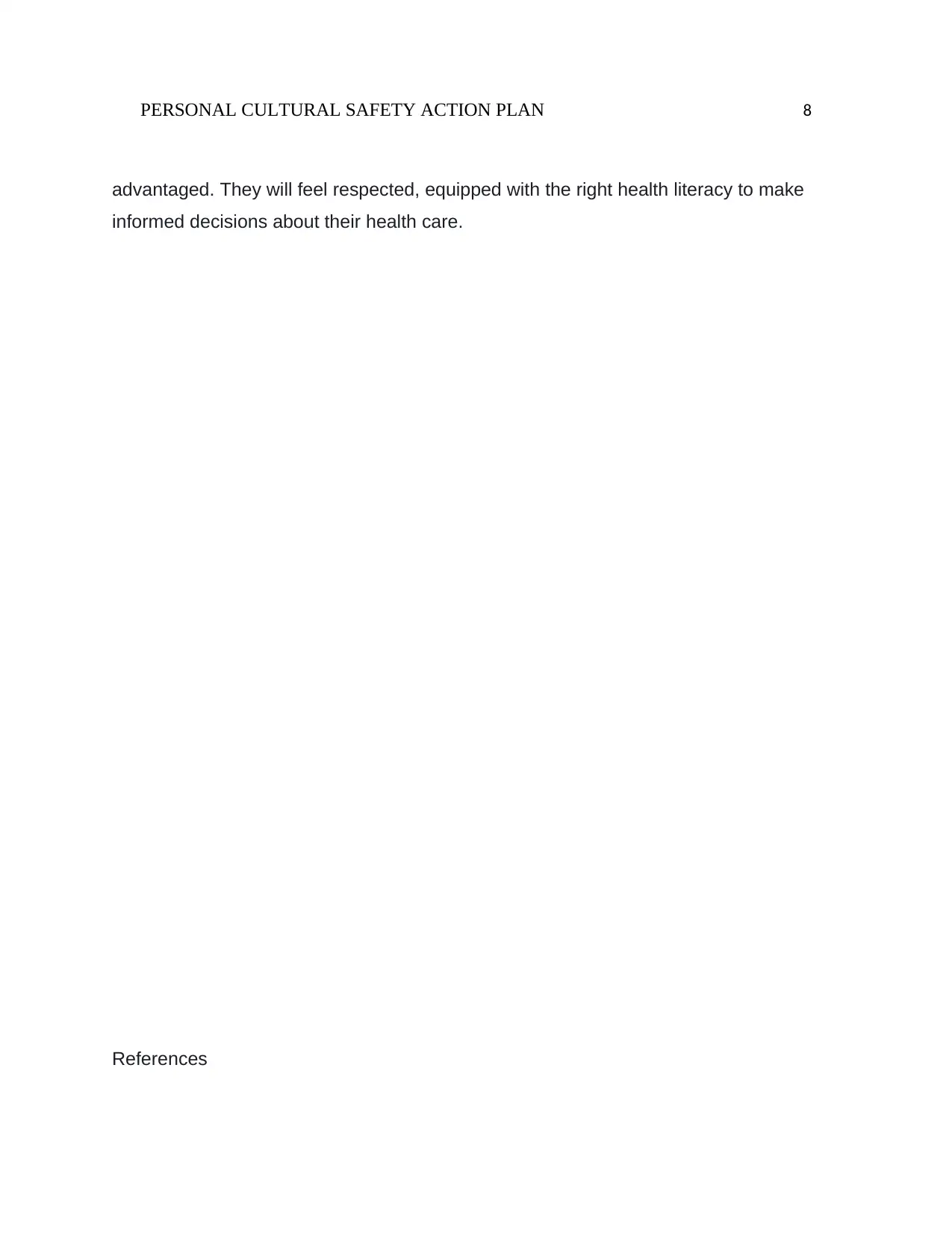
PERSONAL CULTURAL SAFETY ACTION PLAN 8
advantaged. They will feel respected, equipped with the right health literacy to make
informed decisions about their health care.
References
advantaged. They will feel respected, equipped with the right health literacy to make
informed decisions about their health care.
References

PERSONAL CULTURAL SAFETY ACTION PLAN 9
ARIELI , D., FRIEDMAN, V. J., & HIRSCHFELD , M. (2012). Challenges on the path to
cultural safety in nursing education. International Nursing Review, 59(2), 187–
193. https://www.ncbi.nlm.nih.gov/pubmed/22591089
Cherry, B., & Jacob, S. R. (2016). Contemporary nursing: Issues, trends, &
management. Elsevier Health Sciences. London: Havard Printing Press.
https://www.worldcat.org/title/contemporary-nursing-issues-trends-
management/oclc/632070633
Gabriella, B., & Sheree, C. (2014). Clinical supervisors and cultural competence. THE
CLINICAL TEACHER, 11(1), 370-374.
https://www.brown.edu/research/research-ethics/NEEP-bibliographies-
CulturalCompetence-Articles
Holland, K. (2017). Cultural awareness in nursing and health care: an introductory text.
London: Routledge. https://www.crcpress.com/Cultural-Awareness-in-Nursing-
and-Health-Care-An-Introductory-Text/Holland/p/book/9781482245578
Pauly, B., McCall, J., Browne, A. J., Parker, J., & Mollison, A. (2015). Toward cultural
safety. Advances in Nursing Science, 38(2), 121-135.
https://www.ncbi.nlm.nih.gov/pubmed/25932819
Racine, L. (2014). The enduring challenge of cultural safety in nursing. CJNR (Canadian
Journal of Nursing Research), 46(2), 42(6), 6-9.
file:///C:/Users/p/Downloads/2445-2445-1-PB%20(3).pdf
Taylor, K., & Guerin, P. (2019). Health care and Indigenous Australians: cultural safety
in practice. London: Macmillan International Higher Education.
https://www.macmillanihe.com/page/detail/Health-Care-and-Indigenous-
Australians/?K=9781352005424
Wepa, D. (2015). Cultural safety in Aotearoa New Zealand. London: Cambridge
University Press.
http://assets.cambridge.org/97811074/77445/frontmatter/9781107477445_frontm
atter.pdf
ARIELI , D., FRIEDMAN, V. J., & HIRSCHFELD , M. (2012). Challenges on the path to
cultural safety in nursing education. International Nursing Review, 59(2), 187–
193. https://www.ncbi.nlm.nih.gov/pubmed/22591089
Cherry, B., & Jacob, S. R. (2016). Contemporary nursing: Issues, trends, &
management. Elsevier Health Sciences. London: Havard Printing Press.
https://www.worldcat.org/title/contemporary-nursing-issues-trends-
management/oclc/632070633
Gabriella, B., & Sheree, C. (2014). Clinical supervisors and cultural competence. THE
CLINICAL TEACHER, 11(1), 370-374.
https://www.brown.edu/research/research-ethics/NEEP-bibliographies-
CulturalCompetence-Articles
Holland, K. (2017). Cultural awareness in nursing and health care: an introductory text.
London: Routledge. https://www.crcpress.com/Cultural-Awareness-in-Nursing-
and-Health-Care-An-Introductory-Text/Holland/p/book/9781482245578
Pauly, B., McCall, J., Browne, A. J., Parker, J., & Mollison, A. (2015). Toward cultural
safety. Advances in Nursing Science, 38(2), 121-135.
https://www.ncbi.nlm.nih.gov/pubmed/25932819
Racine, L. (2014). The enduring challenge of cultural safety in nursing. CJNR (Canadian
Journal of Nursing Research), 46(2), 42(6), 6-9.
file:///C:/Users/p/Downloads/2445-2445-1-PB%20(3).pdf
Taylor, K., & Guerin, P. (2019). Health care and Indigenous Australians: cultural safety
in practice. London: Macmillan International Higher Education.
https://www.macmillanihe.com/page/detail/Health-Care-and-Indigenous-
Australians/?K=9781352005424
Wepa, D. (2015). Cultural safety in Aotearoa New Zealand. London: Cambridge
University Press.
http://assets.cambridge.org/97811074/77445/frontmatter/9781107477445_frontm
atter.pdf
⊘ This is a preview!⊘
Do you want full access?
Subscribe today to unlock all pages.

Trusted by 1+ million students worldwide

PERSONAL CULTURAL SAFETY ACTION PLAN 10
1 out of 10
Related Documents
Your All-in-One AI-Powered Toolkit for Academic Success.
+13062052269
info@desklib.com
Available 24*7 on WhatsApp / Email
![[object Object]](/_next/static/media/star-bottom.7253800d.svg)
Unlock your academic potential
Copyright © 2020–2025 A2Z Services. All Rights Reserved. Developed and managed by ZUCOL.





